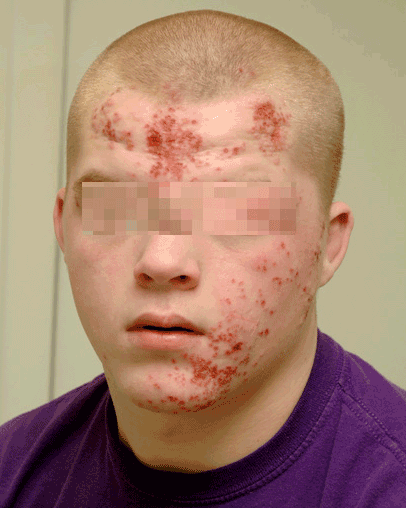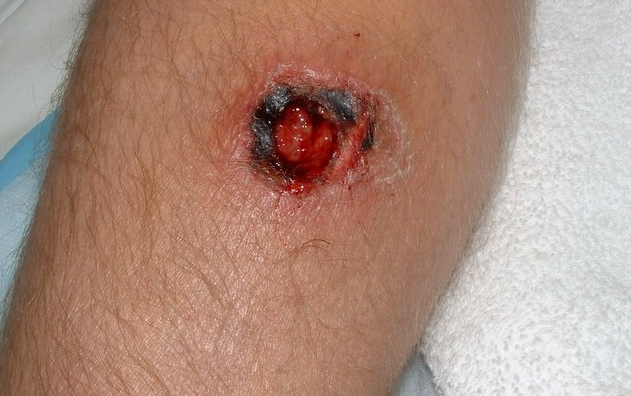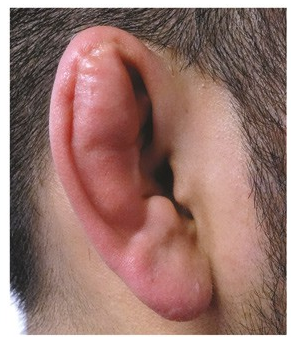Common Injuries in Wrestling

Wrestling is considered one of the oldest sports in the world. It is a popular sport especially in Eastern Europe, Middle East, Asia and North America. In 2004, Olympic comity accepted women’s wrestling as a Olympic game. There are two different types of international wrestling, free-style and Greco-Roman.
In this article, I will try to discuss about the most common infections seen in wrestlers.
Skin Infections
Skin infections are seen in wrestlers for two main reasons. Firstly, repeated skin traumas cause disruption of the skin’s natural barrier, which exposes the body to infections. Secondly, wrestlers frequently contact with microbes that can infect their body.
The skin infections are usually seen on
the head, neck and face parts of the body, where skin contact is most common. The
most common source of germs is the skin of the opponents, not from the environment
or mat.
The most typical causes of skin infection is
herpes simplex virus (HPS). HPS infections are followed by bacteria and fungi
infections. According to NCAA (National Collegiate Athletic Association) and
NFHS (National Federation of State High School Associations), athletes cannot
participate in competitions until the skin disease recover or become non-contagious.
Herpes Gladiatorum (HG)
Herpes Gladiatorum (HG)is a skin infection caused by the herpes simplex virus (HSV1). Fever, fatigue and muscle pain can be accompanied 1 – 2 days before skin infection. Usually the facial vesicles resolve within a week or two. Valacyclovir treatment is used orally 500 – 1000 mg /day for a week. Topical antiviral drugs have not been shown to reduce infectiousness, so its not recommended before using tournaments. Also, if the disease is close to the eye, the ophthalmologist should be consulted.

Primary infection: numerous vesicles have
spread to several dermatomas. Facial infections are often associated with
cervical adenopathy.
Secondary infection: These lesions in wrestlers
are usually not vesicular because they are deformed during sports.
Prevention: Herpes gladiatorum (HG) can spread rapidly among wrestlers. A wrestler with a disease has a 33% chance of transmitting it to another wrestler. The disease occurs approximately 4 to 11 days after this contact. Therefore, 500-1000 mg / day Valacyclovir can be used during the wrestling season to minimize contamination.
Table 1: Under what conditions can the patient return to wrestling
| Infection | NFHS | NCAA |
| HG primary | 10 days in simple HG, 14 days in systemic disease | No new lesions for 3 days |
| HG primary and secondary |
There should be no systemic symptoms. All lesions must heal. Use oral antiviral for 120 hours |
There should be no systemic symptoms. All lesions must end. Use oral antiviral for 120 hours |
| Molluscum Contagiosum | One day after curettage | After the lesion has been treated |
| Bacterial Infections |
All lesions dried No new lesions have been seen in the last two days Taking oral antibiotics for a minimum of 3 days MRSA: taking oral antibiotics for at least 10 days |
All lesions dried No new lesions have been seen in the last two days Taking oral antibiotics for a minimum of 3 days MRSA: taking oral antibiotics for at least 10 days |
| Tinea Gladiatorum |
Oral or topical antifungals should be used for a minimum of 72 hours. Tinea capititis should be used 14 days of treatment. |
Oral or topical antifungals should be used for a
minimum of 72 hours. Tinea capititis should be used 14 days of treatment. |
Common Warts and Molluscum Contagiosum
Viral infections in athlete transmitted through skin to skin contact. Molluscums have their own unique characteristics, and diagnosis is made by this appearance of lesions. Biopsy can also be used for diagnosis. The lesions usually disappear spontaneously within 6 months, but can also be treated by curettage, cryotherapy and chemical ways.
Other Bacterial Skin Infections
They are classified according to the severity of the infection and the presence or absence of systemic symptoms.
- Impetigo
- Folliculitis
- Furuncle
- Carbuncle
- Cellulitis
- Erysipelas
- Methicillin-resistant staphylococcus aureus (MRSA) infections

Tinea Gladiatorum (TG)
Skin fungal infections caused by Tinea corpora occur in approximately 60% of college wrestlers throughout the wrestling season. Diagnosis is based on characteristic appearance which is an erythematous annular plaque with surface scale at the periphery and central clearing. Topical antifungal creams are used for treatment.
Auricular Hematoma
Blunt trauma to the ear causes blood to collect between the perichondrium and the auricular cartilage. The perichondrium layer in the ear is responsible for delivering blood to the ear cartilage. Since the formation of hematoma separates the perichondrium from the cartilage, it causes the cartilage to disappear in time. The new cartilage that will form over time creates a cauliflower ear appearance.

References
- Jarrett, Glenn J., John F. Orwin, and Randall W. Dick. “Injuries in collegiate wrestling.” The American journal of sports medicine 26.5 (1998): 674-680.
- Gottschalk, Andrew William, and Jack T. Andrish. “Epidemiology of sports injury in pediatric athletes.” Sports medicine and arthroscopy review 19.1 (2011): 2-6.
- Pargman, David. Psychological bases of sport injuries. Fitness Information Technology, 1999.
- Pasque, Charles B., and Timothy E. Hewett. “A prospective study of high school wrestling injuries.” The American journal of sports medicine 28.4 (2000): 509-515.
- Yard, Ellen E., et al. “An epidemiologic comparison of high school and college wrestling injuries.” The American journal of sports medicine 36.1 (2008): 57-64.
- Roy, Steven P. “Intercollegiate wrestling injuries.” The Physician and sportsmedicine 7.11 (1979): 83-94.
- Ron Beaschler R. In: Ferguson A, ed. 2015-16 and 2016-17 NCAA Wrestling Rules and Interpretations.
- Hopkins B, ed. 2016-17 NFHS Wrestling Rules Book. Ebook published by Robert B Gardner. Indianapolis,



